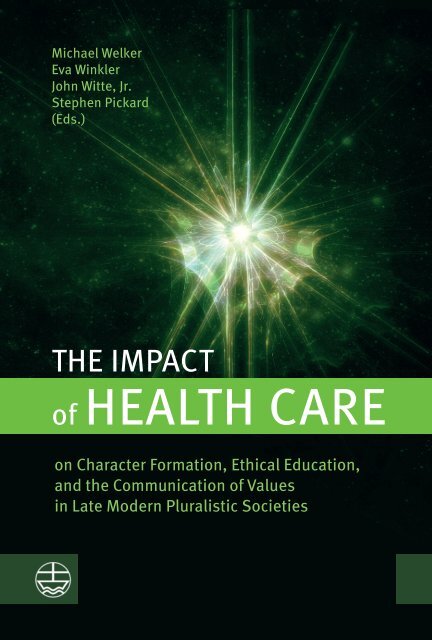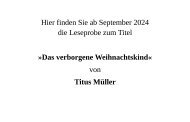Michael Welker | Eva Winkler | John Witte, Jr. | Stephen Pickard (Eds.): The Impact of Health Care (Leseprobe)
Pluralism has become the defining characteristic of many modern societies. Not only a plurality of individual and social claims and activities gain impacts on societal life. A creative pluralism of institutions and their norms profoundly shape our moral commitments and character – notably the family, the market, the media, and systems of law, religion, politics, research, education, health care, and defense. In the theoretical, empirical, and historical contributions to this volume, specialists on medicine, medical ethics, psychology, theology and health care discuss the many challenges that major transformations in their areas of expertise pose to the communication and orientation in late modern pluralistic societies. Contributors come from Germany, the USA and Australia.
Pluralism has become the defining characteristic of many modern societies. Not only a plurality of individual and social claims and activities gain impacts on societal life. A creative pluralism of institutions and their norms profoundly shape our moral commitments and character – notably the family, the market, the media, and systems of law, religion, politics, research, education, health care, and defense.
In the theoretical, empirical, and historical contributions to this volume, specialists on medicine, medical ethics, psychology, theology and health care discuss the many challenges that major transformations in their areas of expertise pose to the communication and orientation in late modern pluralistic societies. Contributors come from Germany, the USA and Australia.
Create successful ePaper yourself
Turn your PDF publications into a flip-book with our unique Google optimized e-Paper software.
<strong>Michael</strong> <strong>Welker</strong><br />
<strong>Eva</strong> <strong>Winkler</strong><br />
<strong>John</strong> <strong>Witte</strong>, <strong>Jr</strong>.<br />
<strong>Stephen</strong> <strong>Pickard</strong><br />
(<strong>Eds</strong>.)<br />
THE IMPACT<br />
<strong>of</strong> HEALTH CARE<br />
on Character Formation, Ethical Education,<br />
and the Communication <strong>of</strong> Values<br />
in Late Modern Pluralistic Societies
Table <strong>of</strong> Contents<br />
Acknowledgments .......................................... 7<br />
Preface to the Series ........................................ 9<br />
<strong>Eva</strong> C. <strong>Winkler</strong> and <strong>Michael</strong> <strong>Welker</strong><br />
Introduction ............................................... 13<br />
Part One: Medical Ethics Between Medicine and Economy<br />
<strong>Eva</strong> C. <strong>Winkler</strong><br />
Time for aNew Oath? <strong>The</strong> Role <strong>of</strong> the Individual Physician’s Ethos and<br />
Institutional Ethics in the Face <strong>of</strong> Economization <strong>of</strong> the <strong>Health</strong>-<strong>Care</strong><br />
System ................................................... 23<br />
Günter Thomas<br />
Mercy under Conditions <strong>of</strong> Scarcity and the Need for Organization; or,<br />
Where Is the Humane Ethos Located in the <strong>Health</strong>-<strong>Care</strong> System? An<br />
Outline <strong>of</strong> the Problem ...................................... 35<br />
Christine Thomas<br />
Ethical Tensions in the Medical Treatment <strong>of</strong>Elderly Patients in<br />
Geriatrics and Geriatric Psychiatry ............................. 45<br />
Part Two: Ethical <strong>Impact</strong>s <strong>of</strong> Advancing Medical Research and<br />
Techniques<br />
Anthony D. Ho<br />
<strong>The</strong> <strong>Impact</strong> <strong>of</strong> Advances in Stem Cell and Genome Research on Ethical<br />
Decision-Making ........................................... 53<br />
Ruth M. Farrell<br />
<strong>The</strong> Acceptance <strong>of</strong> Genetic Technologies by Individuals, Societies, and<br />
<strong>Health</strong>-<strong>Care</strong> Systems ........................................ 65
6 Table <strong>of</strong> Contents<br />
Karla Alex and <strong>Eva</strong> C. <strong>Winkler</strong><br />
Ethical Discourse on Epigenetics and Genome Editing: <strong>The</strong> Risk <strong>of</strong><br />
(Epi )Genetic Determinism and Scientifically Controversial Basic<br />
Assumptions .............................................. 77<br />
Andreas Unterberg and Pavlina Lenga<br />
<strong>The</strong> <strong>Impact</strong> <strong>of</strong> Advances in Surgical Techniques and Quality-<strong>of</strong>-Life<br />
Considerations on Ethical Decision-Making and Education in<br />
Neurosurgery .............................................. 101<br />
Part Three: Digital Medicine and Ethical Decisions<br />
Giovanni Rubeis and Nadia Primc<br />
Ethical Aspects <strong>of</strong> Digital Transformation in Medicine and <strong>Health</strong> <strong>Care</strong> 121<br />
Beate Ditzen and Christian P. Schaaf<br />
Family Decision-Making in Times <strong>of</strong> Genomic Newborn Screening ..... 137<br />
Part Four: <strong>Health</strong> <strong>Care</strong>: History, Education, Practice<br />
Karen Nolte<br />
On the History <strong>of</strong> the Nursing Ethos in Germany .................. 153<br />
Thorsten Moos<br />
<strong>Health</strong>-<strong>Care</strong> Chaplains and Medical Ethics: Clinical and Educational<br />
Experiences ............................................... 165<br />
Gregor Etzelmüller<br />
Medical Anthropology and <strong>The</strong>ology on Human Destiny ............. 175<br />
Peter Kirsch<br />
Psychotherapy, Personality, and the Role <strong>of</strong> Values ................ 197<br />
Contributors .............................................. 203
Acknowledgments<br />
Aconsultation leading to this volume took place at the Forschungszentrum Internationale<br />
und Interdisziplinäre <strong>The</strong>ologie (FIIT) at the University <strong>of</strong> Heidelberg<br />
in April 2022. We are most grateful to the McDonald Agape Foundation<br />
and President Peter McDonald for the generous support <strong>of</strong> the consultation and<br />
this publication.<br />
We thank Gary S. Hauk for his carefulediting <strong>of</strong> the texts and the publishing<br />
houses <strong>Eva</strong>ngelische Verlangsanstalt in Leipzig and Wipf &Stock in Eugene,<br />
Oregon, for their good cooperation.<br />
<strong>Michael</strong> <strong>Welker</strong> and <strong>Eva</strong> C. <strong>Winkler</strong>
Preface to the Series<br />
Five hundred years ago, Protestant reformer Martin Luther argued that “three<br />
estates” (drei Stände) lie at the foundation <strong>of</strong> ajust and orderly society—marital<br />
families, religious communities, and political authorities. Parents in the home;<br />
pastors in the church; magistrates in the state—these, said Luther, are the three<br />
authorities whom God appointed to represent divine justice and mercy in the<br />
world, to protect peace and liberty in earthly life. Household, church, and<br />
state—these are the three institutional pillars on which to build social systems<br />
<strong>of</strong> education and schooling, charity and social welfare, economy and architecture,<br />
art and publication. Family, faith, and freedom—these are the three things<br />
that people will die for.<br />
In the half millennium sinceLuther, historians have uncovered various classical<br />
and Christian antecedents to these early Protestant views. Numerous later<br />
theorists have propounded all manner <strong>of</strong> variations and applications <strong>of</strong> this<br />
three-estates theory, many increasingly abstracted from Luther’s overtly Christian<br />
worldview. Early modern covenant theologians, both Christian and Jewish,<br />
described the marital, confessional, and political covenants that God calls human<br />
beings to form, each directed to interrelated personal and public ends. Social-contract<br />
theorists differentiated the three contracts that humans enter as<br />
they move from the state <strong>of</strong> nature to an organized society protective <strong>of</strong> their<br />
natural rights—the marital contract <strong>of</strong> husband and wife; the government contract<br />
<strong>of</strong> rulers and citizens; and, for some, the religious contracts <strong>of</strong>preachers<br />
and parishioners. Early anthropologists posited three stages <strong>of</strong> development <strong>of</strong><br />
civilization—from family-based tribes and clans, to priest-run theocracies, to<br />
fully organized states that embraced all three institutions. Sociologists distinguished<br />
three main forms <strong>of</strong> authority in an organized community: “traditional”<br />
authority that begins in the home, “charismatic” authority that is exemplified by<br />
the church, and “legal” authority that is rooted in the state. Legal historians outlined<br />
three stages <strong>of</strong> development <strong>of</strong> legal norms—from the habits and rules <strong>of</strong><br />
the family, to the customs and canons <strong>of</strong> religion, to the statutes and codes <strong>of</strong> the<br />
state.
10 Preface to the Series<br />
Already acentury ago, however, scholars in different fields began to flatten<br />
out this hierarchical theory <strong>of</strong> social institutions and to emphasize the foundational<br />
role <strong>of</strong> other social institutions alongside the family, church, and state in<br />
shaping private and public life and character. Sociologists like Max Weber and<br />
Talcott Parsons emphasized the shaping powers <strong>of</strong> “technical rationality” exemplified<br />
especially in new industry, scientific education, and market economies.<br />
Legal scholars like Otto von Gierke and F. W. Maitland emphasized the critical<br />
roles <strong>of</strong> nonstate legal associations (Genossenschaften) inmaintaining ajust social,<br />
political, and legal order historically and today. Catholic subsidiarity theories<br />
<strong>of</strong> Popes Leo XIII and Pius XI emphasized the essential task <strong>of</strong> mediating<br />
social units between the individual and the state to cater the full range <strong>of</strong> needs,<br />
interests, rights, and duties <strong>of</strong> individuals. Protestant theories <strong>of</strong> sphere sovereignty,<br />
inspired by Abraham Kuyper, argued that not only churches, states, and<br />
families but also the social spheres <strong>of</strong> art, labor, education, economics, agriculture,<br />
recreation, and more should enjoy alevel <strong>of</strong> independence from others, especially<br />
an overreaching church or state. Various theories <strong>of</strong> social orstructural<br />
pluralism, civil society, voluntaryassociations, the independent sector, multiculturalism,<br />
multinormativity, and other such labels have now come to the fore in<br />
the ensuing decades—both liberal and conservative, religious and secular, and<br />
featuring all manner <strong>of</strong> methods and logics.<br />
Pluralism <strong>of</strong> all sorts is now acommonplace <strong>of</strong> late modern societies. At<br />
minimum, this means amultitude <strong>of</strong> free and equal individuals and amultitude<br />
<strong>of</strong> groups and institutions, each with very different political, moral, religious,<br />
and pr<strong>of</strong>essional interests and orientations. It includes the sundry associations,<br />
interest groups, parties, lobbies, and social movements that <strong>of</strong>ten rapidly flourish<br />
and fade around acommon cause, especially when aided by modern technology<br />
and various social media. Some see in this texture <strong>of</strong> plurality an enormous<br />
potential for colorful and creative development and arobust expression <strong>of</strong> human<br />
and cultural freedom. Others see achaotic individualism and radical relativism,<br />
which endangers normative education, moral character formation, and<br />
effective cultivation <strong>of</strong> enduring values or virtues.<br />
Pluralism viewed as vague plurality, however, focuses on only one aspect <strong>of</strong><br />
late modern societies—the equality <strong>of</strong> individuals, and their almost unlimited<br />
freedom to participate peaceably at any time asarespected voice in the moral<br />
reasoning and civil interactions <strong>of</strong> asociety. But this view does not adequately<br />
recognize that, beneath the shifting diversity <strong>of</strong> socialforms and norms that constitute<br />
modernity, pluralistic societies have heavy normative codes that shape<br />
their individual and collective values and morals, preferences and prejudices.<br />
<strong>The</strong> sources <strong>of</strong> much <strong>of</strong> this normative coding and moral education inlate<br />
modern pluralistic societies are the deep and powerful social systems that are<br />
the pillars <strong>of</strong> every advanced culture. <strong>The</strong> most powerful and pervasive <strong>of</strong> these<br />
are the social systems <strong>of</strong> law, religion, politics, science/academy, market, media,
Preface to the Series 11<br />
family, education, medicine, and national defense. <strong>The</strong> actual empirical forms <strong>of</strong><br />
each <strong>of</strong> these powerful social systems can and do vary greatly, even in the relatively<br />
homogeneous societies <strong>of</strong> the late modern West. But these deeper social<br />
systems in one form or another are structurally essential and <strong>of</strong>ten normatively<br />
decisive in individual and communal lives.<br />
Every advanced society has acomprehensive legal system <strong>of</strong> justice and order,<br />
religious systems <strong>of</strong> ritual and doctrine, afamily system <strong>of</strong> procreation and<br />
love, an economic system <strong>of</strong> trade and value, amedia system <strong>of</strong> communication<br />
and dissemination <strong>of</strong>news and information, and an educational system <strong>of</strong> creation,<br />
preservation, and application <strong>of</strong> knowledge and scientific advance. Many<br />
advanced societies also have massive systems <strong>of</strong> science, technology, health<br />
care, and national defense with vast influence over and through all <strong>of</strong> these other<br />
social systems. <strong>The</strong>se pervasive social systems lie at the foundation <strong>of</strong> modern<br />
advanced societies, and they anchor the vast pluralities <strong>of</strong> associations and social<br />
interactions that might happen to exist at any given time.<br />
Each <strong>of</strong> these social systems has internal value systems, institutionalized<br />
rationalities, and normative expectations that together help to shape each individual’s<br />
morality and character. Each <strong>of</strong> these social spheres, moreover, has its<br />
own pr<strong>of</strong>essionals and experts who shape and implement its internal structures<br />
and processes. <strong>The</strong> normative network created by these social spheres is <strong>of</strong>ten<br />
harder to grasp today, since late modern pluralistic societies usually do not<br />
bring these different value systems to light under the dominance <strong>of</strong> just one organization,<br />
institution, and power. And this normative network has also become<br />
more shifting and fragile, especially since traditional social systems, such as religion<br />
and the family, haveeroded in theirdurabilityand power, and other social<br />
systems, such as science, the market, healthcare, defense, and the media, have<br />
become more powerful.<br />
<strong>The</strong> aim <strong>of</strong> this project on “Character Formation and Ethical Education in<br />
Late Modern Pluralistic Societies” is to identify the realities and potentials <strong>of</strong><br />
these core social systems to provide moral orientation and character formation<br />
in our day. What can and should these social spheres, separately and together,<br />
do in shaping the moral character <strong>of</strong> late modern individuals who, by nature,<br />
culture, and constitutional norms, are free and equal in dignity and rights?What<br />
are and should be the core educational functions and moral responsibilities <strong>of</strong><br />
each <strong>of</strong> these social spheres?How can we better understand and better influence<br />
the complex interactions among individualism, the normative binding powers <strong>of</strong><br />
these socialsystems, and the creativity <strong>of</strong> civil groups and institutions?How can<br />
we map and measure the different hierarchies <strong>of</strong> values that govern each <strong>of</strong><br />
these social systems, and that are also interwoven and interconnected in various<br />
ways in shaping late modern understandings <strong>of</strong> the common good? How do we<br />
negotiate the boundaries and conflicts between and among these social systems<br />
when one encroaches on the other, or imposes its values and rationalities on
12 Preface to the Series<br />
individuals at the cost <strong>of</strong> the other social spheres or <strong>of</strong> the common good? What<br />
and where are the intrinsic strengths <strong>of</strong> each social sphere that should be made<br />
more overt in character formation, public education, and the shaping <strong>of</strong> minds<br />
and mentalities?<br />
<strong>The</strong>se are some <strong>of</strong> the guiding questions at work in this project and in this<br />
volume. Our project aims to provide asystematic account <strong>of</strong> the role <strong>of</strong> these<br />
powerful normative codes operating in the social spheres <strong>of</strong> law, religion, the<br />
family, the market, the media, science and technology, the academy, health care,<br />
and military and defense systems in the late modern liberal West. Our focus is<br />
on selected examples and case studies drawn from Western Europe, North America,<br />
South Africa, and Australia, which together provide just enough diversity to<br />
test out broader theories <strong>of</strong> character formation and moral education. Our scholars<br />
are drawn from across the academy, with representative voices from the humanities,<br />
social sciences, and natural sciences as well as the pr<strong>of</strong>essions <strong>of</strong> theology,<br />
law, business, and medicine. While most <strong>of</strong> our scholars come from the<br />
Protestant and Catholic worlds, our endeavor is to <strong>of</strong>fer comparative insights<br />
that will help scholars from any pr<strong>of</strong>ession or confession. While our laboratory<br />
is principally Western liberal societies, the modern forces <strong>of</strong> globalization will<br />
soon make these issues <strong>of</strong> moral character formation aconcern for every culture<br />
and region <strong>of</strong> the world—given the power <strong>of</strong> global social media, entertainment,<br />
and sports; the pervasiveness <strong>of</strong> global finance, business, trade, and law; and the<br />
perennial global worries over food, health care, environmental degradation, and<br />
natural disasters.<br />
In this volume, we focus in on the role <strong>of</strong> health care and health-care systems<br />
in shaping character development, ethical education, and the communication<br />
<strong>of</strong> values in late modern pluralistic societies.<br />
<strong>Michael</strong> <strong>Welker</strong>, University <strong>of</strong> Heidelberg<br />
<strong>Eva</strong> C. <strong>Winkler</strong>, University <strong>of</strong> Heidelberg<br />
<strong>John</strong> <strong>Witte</strong> <strong>Jr</strong>., Emory University<br />
<strong>Stephen</strong> <strong>Pickard</strong>, Charles Sturt University
Introduction<br />
<strong>Eva</strong> C. <strong>Winkler</strong> and <strong>Michael</strong> <strong>Welker</strong><br />
This volume focuses on the role <strong>of</strong> health care and medicine in their impact on<br />
character formation, ethical education, and the communication <strong>of</strong>values in late<br />
modern pluralistic societies. <strong>The</strong> contributions are arranged in four sections. <strong>The</strong><br />
first deals with the tensions that medical ethics faces between the demands <strong>of</strong><br />
medical ethos and the challenges <strong>of</strong> the economization <strong>of</strong> health care. <strong>The</strong> second<br />
part addresses ethical impacts <strong>of</strong> advancing medical research and techniques.<br />
<strong>The</strong> third part looks at some ethical aspects <strong>of</strong> the digital transformation<br />
in medicine and health care. <strong>The</strong> fourth part is concerned with developments in<br />
ethos and education in health care and medicine, with different perspectives on<br />
human destiny in medical anthropology and theology, and with aview <strong>of</strong> psychotherapy<br />
on the topics <strong>of</strong> the volume.<br />
Part One addresses the ethical tensions in the health-care system between<br />
pr<strong>of</strong>essional responsibilities toward the individual patient and realizing those<br />
responsibilities in acomplex health-care system with limited resources.<br />
<strong>Eva</strong> C. <strong>Winkler</strong> sets out to define the role <strong>of</strong> pr<strong>of</strong>essional ethics for the individual<br />
doctor as well as deriveddesiderata for organizational ethics in the face <strong>of</strong><br />
economization <strong>of</strong> the health-care system in Germany, where financial pressure<br />
has increased in recent years. She reports the empirical data indicating that the<br />
so-called economization has significant impact on medical decision-making and<br />
action and consequently potentially also on the doctor–patient relationship.<br />
While economic considerations are necessary and in part desired—for example,<br />
when the same goal can be achieved by less expensive means—other economic<br />
incentives can compromise the quality <strong>of</strong> treatment and trust in the entire medical<br />
pr<strong>of</strong>ession.<br />
She starts with the physician’sperspective on economic incentives reflected<br />
in empirical data and then analyzes three different responses to cost pressure<br />
from anormative perspective withconsiderations about the appropriateforms <strong>of</strong><br />
economization in the medical system: enhancing efficiency, increasing revenue,<br />
and rationing or forgoing effective medical interventions to save money. She<br />
then evaluates the types <strong>of</strong> ethical guidance available to physicians to resolve
14 <strong>Eva</strong> C. <strong>Winkler</strong> and <strong>Michael</strong> <strong>Welker</strong><br />
tensions between their mission toensure their patients’ welfare, on one hand,<br />
and their responsibility for cost-conscious decisions, on the other. Finally, she<br />
illuminates the limitations <strong>of</strong> “appeals to individual ethos” and personal responsibility,<br />
and she discusses the necessary embedding <strong>of</strong> the individual in institutional<br />
ethics and the importance <strong>of</strong> decision-making above the patient-physician<br />
level. She then proposes potentialguardrails for ethical decision-making in view<br />
<strong>of</strong> cost considerations.<br />
Günter Thomas begins with reflections onthe theological-historical background<br />
<strong>of</strong> an ethos <strong>of</strong>caring for the sick in Christianity and beyond. This ethos<br />
has <strong>of</strong>ten been considered in frameworks <strong>of</strong> person-to-person relations. This orientation,<br />
however, has to be re-investigated today with respect to the social distribution<br />
<strong>of</strong> values in health-care organizations. Thomas names the complexnetwork<br />
<strong>of</strong> medical institutions, health insurers, public or government funding <strong>of</strong><br />
health care, the ethos <strong>of</strong> human actors and clinical staff, and the various expectations<br />
<strong>of</strong> patients. How to orchestrate this complex network with its differing<br />
value systems <strong>of</strong> orientation and the associated expectations? How to deal with<br />
the problem that “organizedcommunities <strong>of</strong> solidarity must always be inclusive<br />
and exclusive at the same time in order to function effectively”?<br />
Thomas concludes with considerations on “orientational distress.” He asks<br />
for religious, academic, and civil-societal contexts in which broader visions <strong>of</strong> a<br />
good, fulfilled, and successful life can be discussed “without damaging the latent<br />
protection in the health-care organization itself.” He argues for intensified discourses<br />
between those who deal with religiously and ethically based value orientation<br />
and those who deal with the ethical and practical challenges <strong>of</strong>health<br />
care in order to reduce orientational distress and prevent eventual burnout.<br />
ChristineThomas specifies such challengeswith respect to the medical treatment<br />
<strong>of</strong> elderly patients. She describes conflicts over apatient’s sovereignty <strong>of</strong><br />
interpretation and decision-making, conflicts between patients and their relatives<br />
or younger generations, and conflicts also between patients and families,<br />
on one hand, and medical and therapeutic practitioners, on the other. Abroad<br />
spectrum <strong>of</strong> potential problems arises, from unrealistic demands for maximum<br />
therapy to aresigned “nihilism” <strong>of</strong> frail patients or alaissez-faire attitude on the<br />
part <strong>of</strong> the patient or relatives, but also from limitations in hospital financing<br />
and mental and physical capacities <strong>of</strong> the medical and nursing staff.<br />
She pleads to uphold the demands <strong>of</strong> ethical responsibility and acommunity<br />
<strong>of</strong> solidarity, to “return to the principle <strong>of</strong> no harm” in medical practice and to<br />
“initiatives such as ‘choosing wisely’” between overmedication and underuse.<br />
She also argues for “targeted face-to-facecommunication between treatment providers<br />
and patients” and the eventual “moderation <strong>of</strong> an ethics adviser.”<br />
Part Two <strong>of</strong> this book turns to ethical challenges that come with advancing<br />
medical research and techniques.
Introduction 15<br />
Anthony D. Ho uses the powerful tool <strong>of</strong> storytelling and shares stories <strong>of</strong><br />
cancer patients to illustrate situations that call for ethical considerations. <strong>The</strong><br />
first story raises questions about how far apatient with terminal disease should<br />
be encouraged to undergo experimental treatments with unknown risks, and it<br />
highlights the inherent tension between palliative care and early-phase clinical<br />
studies for advancingscience. <strong>The</strong> second is asuccess story about apatient who<br />
also received anew and experimental treatment—a stem cell transplantation—<br />
and raises ethical questions about the balance between individual health needs<br />
and community resource allocation, the financial gains <strong>of</strong> expensive medical<br />
procedures, and the justified price <strong>of</strong> anovel product or pr<strong>of</strong>it margin for the<br />
pharmaceutical industry. <strong>The</strong> third story highlights the detrimental impact <strong>of</strong><br />
prematurecommunication <strong>of</strong> not-yet consolidatedscientific advances on clinical<br />
decision-making and concludes that properly conducted research is paramount<br />
to establish robust evidence and efficacy <strong>of</strong> novel treatments. As an example <strong>of</strong><br />
successfulregulation, the chapter portrays the development <strong>of</strong> the German Stem<br />
Cell Act—a regulation that permits scientific advances under ethical considerations.<br />
With these stories, Ho highlights not only the character formation required<br />
for proper interaction with patients, but also the ethical challenges that<br />
arise as medical technology advances, and he underscores the need for ongoing<br />
ethical education and communication <strong>of</strong> values in the health-care system.<br />
Ruth M. Farrell reports on advances in genomic science and technology that<br />
have had an impact on reproductive health care, particularly prenatal care,<br />
where genetic tests can inform decisions about reproductive health and family<br />
building. However, the complexity and uncertainty <strong>of</strong> genomic information before<br />
birth present challenges for patients, families, and society. Prenatal genetic<br />
tests can inform significant decisions during pregnancy, including the possibility<br />
<strong>of</strong> ending the pregnancy if aserious condition is diagnosed. Farrell draws a<br />
very nuanced picture. On one hand, itisimportant that decisions about the use<br />
<strong>of</strong> genetic testing reflect the values, needs, and goals <strong>of</strong> pregnant women and<br />
their families. On the other hand, these decisions are also embedded and thus<br />
influenced by social systems, which impact actionability and agency during<br />
pregnancy, with significant ramifications for individuals, families, communities,<br />
and future generations.<br />
Farrell illustrates the various spheres <strong>of</strong> influence that determine agency:<br />
first, the ability to access genetic testing and to process and interpret the information<br />
about genetic test results, but also the options provided to act upon the<br />
information and decide whether to end apregnancy. She not only raises concerns<br />
about awoman’s ability to access abortion services in the United States<br />
if asevere fetal genetic condition is identified. She also considers whether a<br />
medical condition perceived asdysfunction is not only amatter <strong>of</strong> science but<br />
also in part socially determined and dependent upon the social infrastructure<br />
that enables differently abled individuals tointeract within their families and
16 <strong>Eva</strong> C. <strong>Winkler</strong> and <strong>Michael</strong> <strong>Welker</strong><br />
communities. Hence, she illustrates how scientific development is influenced by<br />
societal values, which establish parameters for the acceptable uses <strong>of</strong> technology.<br />
Karla Alex and <strong>Eva</strong> C. <strong>Winkler</strong> write about new developments in genetics and<br />
epigenetics research, and take alook at scientifically and ethically contested<br />
conceptions that form the ethical, scientific, and popular scientific discourse.<br />
<strong>The</strong> chapter includes two tables that concisely summarize the new research<br />
techniques <strong>of</strong> epigenome editing and genome editing, as well as several -isms<br />
and their respective discourse areas. <strong>The</strong>ses -isms are conceptions about the impact<br />
<strong>of</strong> genetics and epigenetics on aperson’s (and potentially their descendants’)<br />
life and associated responsibilities for health. Alex and <strong>Winkler</strong> keenly<br />
scrutinize and critically assess these conceptions.<br />
Building on this analysis, they compare the ethical debate on genome editing<br />
with the ethical debate on epigenetics. <strong>The</strong>y show that the concept <strong>of</strong> genetic<br />
determinism might be indirectly present in contemporary discussions on genome<br />
editing. Likewise, they note how notions <strong>of</strong> epigenetic determinism are<br />
present across scientific, ethical, and popular scientific discourse, especially in<br />
the form <strong>of</strong> the presumption <strong>of</strong> heritability <strong>of</strong> epigenetic information acquired<br />
during life. <strong>The</strong> authors point out that this presumption is at best scientifically<br />
contested (if not unproven) for humans, afact that is beginning tobeacknowledged<br />
in ethical discourse, with aresulting shift <strong>of</strong>focus in epigenetics discourse<br />
from individual responsibilities to social and environmental justice at<br />
apopulation level. In conclusion, they argue that concepts like genetic and epigenetic<br />
determinism “are increasingly viewed critically in ethical discourse because<br />
they cannot be confirmed scientifically. In popular scientific debates in<br />
particular, however, they seem to persist, which ultimately also influences the<br />
public discussion. Since abroad public discussion is required especially for genome<br />
editing, areflective handling <strong>of</strong> the different -isms analyzedinthis chapter<br />
is central.”<br />
Andreas Unterberg and Pavlina Lenga examine the implications <strong>of</strong> technological<br />
advances in surgery that have led to the challenge <strong>of</strong> sub- or superspecialization.<br />
<strong>The</strong>y set out by compiling the inventory that is necessary for aneurosurgeon<br />
nowadays to maneuver the choppy waters <strong>of</strong> ethical challenges:<br />
pr<strong>of</strong>essionalism and apledge to put the patient’sinterest first; transparencyand<br />
awareness <strong>of</strong> conflicts <strong>of</strong> interest with the pharmaceutical or technical-device<br />
industry; shareddecision-making oriented toward the patient’sgoals and values;<br />
and education that sensitizes neurosurgical trainees to the ethical dimensions <strong>of</strong><br />
their daily work.<br />
<strong>The</strong> authors highlight the four midlevel principles <strong>of</strong> medical ethics (respect<br />
for autonomy, beneficence, nonmaleficence, and justice) as guardrails for such<br />
ethical evaluation. <strong>The</strong>y exemplify the weighing <strong>of</strong> quality <strong>of</strong> life, survival time,<br />
and other patient-oriented factors by using three different disease scenarios. <strong>The</strong>
Introduction 17<br />
first presents glioblastoma as avery aggressive brain tumor that affects the patient’s<br />
quality <strong>of</strong> life significantly, while surgery can restore quality <strong>of</strong> life. <strong>The</strong><br />
second scenario describes the course <strong>of</strong> benign tumors, such as craniopharyngiomas,<br />
where surgical resection can lead to worsenedquality <strong>of</strong> life. In the third<br />
case, age-related degenerative changes can affect the spinal elements, leading to<br />
neurogenic claudication or lumbar radiculopathy and adecrease in mobility and<br />
quality <strong>of</strong> life, where there is no clear consensus onthe optimal treatment for<br />
octogenarians, although surgery even in very old and frail patients can be beneficial.<br />
In Part Three, we turn to some ethical aspects connected with the digital<br />
transformation <strong>of</strong> medicine and health care.<br />
<strong>The</strong> seminal contribution by Giovanni Rubeis and Nadia Primc aims to overcome<br />
confusions and worries connected with the “umbrella concept <strong>of</strong> digital<br />
transformation,” which covers automation, mechanization, machinization, robotization,<br />
and data-driven technologies, and is promoted by different academic disciplines<br />
and stakeholders with very different perspectives and interests. How<br />
can a “digital disruption <strong>of</strong> health care” be avoided and a “process <strong>of</strong> incremental<br />
change and (intended) improvement <strong>of</strong> health care” through digital technologies<br />
be envisioned?<br />
<strong>The</strong> chapter identifies three criteria for positive developments:<br />
emphasis on the autonomy <strong>of</strong> patients in the form <strong>of</strong> their participation in<br />
the treatment process, and the critical evaluation <strong>of</strong> factors that hinder empowerment;<br />
differentiating technologies that support autonomy from technologies that<br />
risk the well-being <strong>of</strong>patients;<br />
investigation <strong>of</strong> the introduction <strong>of</strong> nonhuman actors into the clinical encounter<br />
with the question whether they support or minimize “the willingness<br />
<strong>of</strong> patients to trust health pr<strong>of</strong>essionals.”<br />
After pondering open questions <strong>of</strong> “justice and inequalities in digitalized health<br />
care,” the chapter identifies helpful strategies to promote digital transformation:<br />
aparticipatory technological design; transparency <strong>of</strong> “parameters <strong>of</strong> an algorithm-based<br />
system”; and acontinuous improvement <strong>of</strong> “health-care literacy.”<br />
It concludes with acall for “respect <strong>of</strong> the autonomy <strong>of</strong> patients, the promotion<br />
<strong>of</strong> well-being <strong>of</strong>patients, and the prevention <strong>of</strong> inequalities between patients.”<br />
Beate Ditzen and Christian P. Schaaf anticipate yet another important advancement<br />
in medicine—genetic newborn screening. Geneticnewbornscreening<br />
is aprocess that can identify specific diseases in newborns that require early<br />
intervention to improve health or save lives. Predictive genetic testing is also<br />
available for families with ahistory <strong>of</strong>childhood-onset disorders, where preventive<br />
interventions are available.<strong>The</strong> authors report on the factors that are important<br />
for individuals and families during and following genetic testing in general
Part One:<br />
Medical Ethics Between<br />
Medicine and Economy
Time for aNew Oath? <strong>The</strong> Role <strong>of</strong><br />
the Individual Physician’s Ethos and<br />
Institutional Ethics in the Face <strong>of</strong><br />
Economization <strong>of</strong> the <strong>Health</strong>-<strong>Care</strong><br />
System<br />
<strong>Eva</strong> C. <strong>Winkler</strong><br />
<strong>The</strong> topic <strong>of</strong> economization in the health-care system has been rampant for many<br />
years, but has been gaining momentum in Germany since 2018 inparticular,<br />
with anumber <strong>of</strong> wake-up calls. <strong>The</strong> Association <strong>of</strong> the Scientific Medical Societies<br />
in Germany (AWMF) published anaction paper against the undue influence<br />
<strong>of</strong> economic interests on medical decisions. 1 <strong>The</strong> popular magazine Der<br />
Stern published an urgent request against the economization <strong>of</strong>German hospitals<br />
that was signed by numerous medical associations, specialist societies, individual<br />
doctors, and well-known medical ethicists. 2 And in 2021, at the annual<br />
meeting <strong>of</strong> the German Medical Association, the delegates overwhelmingly supported<br />
the proposal against commercialization in the health-care system made<br />
by the board <strong>of</strong> directors <strong>of</strong> the German Medical Association (BÄK), saying, “<strong>The</strong><br />
medical pr<strong>of</strong>ession rejects performance, financial, resource, and behavioral requirements<br />
that affect responsible medical practice and are incompatible with<br />
medical ethics.” 3<br />
<strong>The</strong>se appeals speak tothe dilemma that many physicians face—on one<br />
hand, the mandate to provideastandard <strong>of</strong> care and contribute to the well-being<br />
<strong>of</strong> their patients, and on the other hand, the need to be held responsible for<br />
their own department, clinical practice, orhospital to be economically balanced<br />
or even togenerate revenues. <strong>The</strong> debate also shows that the term “economization”<br />
is used to mean everything from practices <strong>of</strong>increasing efficiency to aprimary<br />
pr<strong>of</strong>it orientation in health care.<br />
1<br />
2<br />
3<br />
AWMF, “Medizin und Ökonomie—Maßnahmen fu reine wissenschaftlich begru ndete,<br />
patientenzentrierte und ressourcenbewusste Versorgung.”<br />
“Der Ärzteappel—gegen die Diktatur der Ökonomie in unseren Krankenhäusern,” Der<br />
Stern, no. 37, Sep. 5, 2019.<br />
Deutsches Ärzteblatt, Nov. 2, 2021, “Ärztetag lehnt Kommerzialisierung ab,” https://<br />
www.aerzteblatt.de/nachrichten/128581/Aerztetag-lehnt-Kommerzialisierung-ab-aer<br />
ztliches-Handeln-muss-unbeeinflusst-bleiben.
24 <strong>Eva</strong> C. <strong>Winkler</strong><br />
In this chapter, Iuse the term to describe aprocess in which the logic <strong>of</strong><br />
medical decisions is possibly influenced through economic goals and modes <strong>of</strong><br />
action. 4 That is, the concept <strong>of</strong> economization is used descriptively and valueneutrally.<br />
It can therefore indicate ethically positive as well as negative consequences<br />
<strong>of</strong>such an economic influence on the medical logic <strong>of</strong> action.<br />
One example <strong>of</strong> the positive effects <strong>of</strong> economic considerations in medical<br />
practice is the rationalization <strong>of</strong> work steps to optimize the time/result ratio<br />
without negatively impacting the quality <strong>of</strong> patient care. Examples <strong>of</strong> negative<br />
effects include the performance <strong>of</strong> procedures that are not medically indicated<br />
due to financial incentives, or forgoing medically indicatedmeasures in order to<br />
save costs (rationing). Different degrees <strong>of</strong>economization can be distinguished.<br />
Accordingly, both contexts in which cost considerations play no role at all and<br />
those in which costs do play adecisive role are conceivable in the extreme<br />
forms, as are contexts in which apr<strong>of</strong>it must be made in any case. 5<br />
Reasons for Economization and Empirical Data on<br />
Economic Influences in <strong>Health</strong> <strong>Care</strong><br />
<strong>The</strong> background reasons for the increasing economization inthe German medical<br />
system are manifold. <strong>The</strong> drivers <strong>of</strong> rising costs are longer life expectancy<br />
and rising therapeutical costs. Against the background <strong>of</strong> limited resources,<br />
health-care expenditures have been regulated in recent years and decades by<br />
avariety <strong>of</strong>political and legal instruments. One example <strong>of</strong> this is the financing<br />
<strong>of</strong> inpatient care introduced in 2004 through the G-DRG system (German version<br />
<strong>of</strong> the Diagnoses Related Groups reporting and reimbursement system), which<br />
has also been studied with regard to its possible effects on care. 6 Physicians and<br />
other health-care pr<strong>of</strong>essionals have repeatedly pointed out that the financial<br />
pressures on the German medical system have increased in recent years, and<br />
that the so-called economization has considerable consequences for medical de-<br />
4<br />
5<br />
6<br />
Heiner Raspe, “Indikationsstellung in der klinischen Medizin: Dem Individuum und/<br />
oder dem Patientenkollektiv verpflichtet?,” Medizinrecht 34, no. 4(2016): 248–50, DOI:<br />
10.1007/s00350–016–4244-y.<br />
Arne Manzeschke, “Die effiziente Organisation,” Ethik in der Medizin 23, no. 4(2011):<br />
271–82.<br />
Bernard Braun et al., Pauschalpatienten, Kurzlieger und Draufzahler. Auswirkungen der<br />
DRGs auf Versorgungsqualität und Arbeitsbedingungen im Krankenhaus (Bern: Huber,<br />
2010); and Antonius Reifferscheid, Dominik Thomas, and Jürgen Wasem, “Zehn Jahre<br />
DRG-System in Deutschland–<strong>The</strong>oretische Anreizwirkungen und empirische Evidenz,”<br />
Krankenhaus-Report 2013 (Stuttgart: Schattauer, 2013), 3–19.
Time for aNew Oath? 25<br />
cision-making and actions. 7 <strong>The</strong> influence <strong>of</strong> financial incentives on physician<br />
decision-making has been empirically investigated in afew studies in recent<br />
years. Exemplary <strong>of</strong>this are data indicating that medical interventions and<br />
measures are adapted to the possibilities for billing. 8 Economic factors are also<br />
describedbyphysicians as relevant to their actions. 9 Asurvey <strong>of</strong> more than four<br />
thousand members <strong>of</strong> the German Society for Internal Medicine (DGIM) shows<br />
that measures are carried out or omitted due to financial incentives: 70 percent<br />
<strong>of</strong> the participants state that they are confronted several times aweek with the<br />
decisionwhether to perform ameasure based on economic considerations. 10 <strong>The</strong><br />
majority <strong>of</strong> respondents saw overtreatment as arelevant problem. Overtreatment<br />
occurs when medical measures are carried out that have no demonstrable<br />
benefit, usually to generate additional revenue.<br />
In the field <strong>of</strong> oncology, which is quite cost intensive, only afew empirical<br />
and interdisciplinary studies on the possible influence <strong>of</strong> economic factors are<br />
available in Germany. Asurvey <strong>of</strong> 345 members <strong>of</strong> the German Society for Hematology<br />
and Oncology (DGHO) showed that the respondents fear adeterioration<br />
<strong>of</strong> care as aconsequence <strong>of</strong>cost pressure, and more than half <strong>of</strong> the participants<br />
reported undertreatment—meaning not <strong>of</strong>fering beneficial treatment<br />
for cost reasons. 11 For cost reasons, 63percent <strong>of</strong> the oncologists reported discharging<br />
patients prematurely for outpatient care, although inpatient treatment<br />
would havemadeclinical sense. Only athird stated that they had never done so.<br />
Sixty-four percent stated that they initially did not use an indicated but expensive<br />
measure and waited to see whether the patient could manage without it;<br />
fortunately, most <strong>of</strong> these reported not doing this very <strong>of</strong>ten, or less than once<br />
7<br />
8<br />
9<br />
10<br />
11<br />
Giovanni Maio, “Gefährdung der Patientensicherheit im Zeitalter der DRGs,” Zeitschrift<br />
für Evidenz Fortbildung und Qualität im Gesundheitswesen 108, no. 1(2014): 32–34; and<br />
Monika Nothacker et al., “Medizin und Ökonomie: Maßnahmen fu reine wissenschaftlich<br />
begru ndete, patientenzentrierte und ressourcenbewusste Versorgung. Ein Strategiepapier<br />
der Arbeitsgemeinschaft der Wissenschaftlichen Medizinischen Fachgesellschaften<br />
(AWMF),” Deutsche Medizinische Wochenschrift 144, no. 14 (2019): 990–96.<br />
Deutscher Ethikrat, Patientenwohl als ethischer Maßstab fu rdas Krankenhaus, 2016,<br />
https://www.ethikrat.org/fileadmin/Publikationen/Stellungnahmen/deutsch/stellung<br />
nahme-patientenwohl-als-ethischer-massstab-fuer-das-krankenhaus.pdf.<br />
Karl-Heinz Wehkamp and Heinz Naegler, “<strong>The</strong> Commercialization <strong>of</strong> Patient-Related Decision<br />
Making in Hospitals: AQualitative Study <strong>of</strong> the Perceptions <strong>of</strong> Doctors and Chief<br />
Executive Officers,” Deutsches Ärzteblatt International 114, no. 47 (2017): 797.<br />
Gerd Hasenfuß et al., “Initiative ‘Klug entscheiden’:Gegen Unter- und Überversorgung,”<br />
Deutsches Ärzteblatt International 113, no. 13 (2016): A–600.<br />
Stefan W. Krause et al., “Rationing Cancer <strong>Care</strong>: ASurvey among the Members <strong>of</strong> the<br />
German Society <strong>of</strong> Hematology and Oncology,” Journal <strong>of</strong> the National Comprehensive<br />
Cancer Network 11, no. 6(2013): 658–65.
26 <strong>Eva</strong> C. <strong>Winkler</strong><br />
amonth. Fifty-nine percent reported that they withheld therapeutic measures<br />
for cost reasons, even though the measures were approved and would have a<br />
demonstrable advantage over cheaper alternatives, because—in the calculation<br />
<strong>of</strong> these physicians—the therapeutic benefit was too small compared to the difference<br />
in cost. 12<br />
Many oncologists experience arole conflict in making decisions about the<br />
provision <strong>of</strong> indicated but expensive therapies. In particular, the ambivalence<br />
between the goal <strong>of</strong> promoting the well-being <strong>of</strong> the patient and, at the same<br />
time, the need to deal appropriately with the cost pressure on the clinics was<br />
viewed as problematic. 13 Hence, many doctors feel caught between two demands—namely,<br />
between that <strong>of</strong> patients, who rightly demand the best available<br />
care, and that <strong>of</strong> society, which expects that physicians, as gatekeepers, must<br />
use the system’s resources wisely, or even one step further, commercially oriented<br />
hospitals, which expect that health care will generate revenue.<br />
Different Strategies toDeal with Cost Pressures and<br />
<strong>The</strong>ir Ethical <strong>Eva</strong>luation<br />
We have seen from reported studies that there are at least three different strategies<br />
in practice to respond to cost pressures:<br />
a.) enhancing efficiency to achieve the same result with fewer resources;<br />
b.) increasing revenue—that is, putting more money into the system either by<br />
redistributing public money into the health sector or by generating more<br />
revenues in the health system itself;<br />
c.) rationing or forgoing effective medical interventions to save money.<br />
In the following, all three strategies are discussed with regard totheir ethical<br />
justifiability.<br />
Increasing Efficiency<br />
Rationalization, understood as guaranteeingthe same treatment result with less<br />
resource input, is ethically unproblematic, provided that all relevant input variables<br />
are included in the calculation. This excludes, for example, the case where<br />
agoal can beachieved only through unpaid overtime or at the expense <strong>of</strong> time<br />
spent talking to patients. In the DRG system, for example, talking medicine in<br />
12<br />
13<br />
See Hasenfuß et al., “Initiative ‘Klug entscheiden.’”<br />
Sandra Fernau et al., “<strong>The</strong> Role <strong>of</strong> Physicians in Rationing Cancer <strong>Care</strong>: Attitudes <strong>of</strong><br />
German Oncologists,” Oncology Research and Treatment 40, no. 9(2017): 490–94.
Time for aNew Oath? 27<br />
the sense <strong>of</strong> involving patients in jointdecision-making or involvingrelatives in<br />
the course <strong>of</strong> treatment is not abasis for remuneration, whereas other services<br />
(for example, surgical interventions or ventilation) are constitutive for aDRG<br />
case group and thereby aprerequisite for billing. Interdisciplinary or interpr<strong>of</strong>essional<br />
coordination isalso largely uncompensated. Thus, streamlining this<br />
system is likely done at the expense <strong>of</strong> time for patient-centered care—especially<br />
for time- and personnel-intensive treatment <strong>of</strong> children and adolescents, but also<br />
<strong>of</strong> frail elders. Clarifying complex cases and joint decision-making are therefore<br />
not aneutral increase <strong>of</strong> efficiency. 14<br />
However, aslong as economization in the form <strong>of</strong> streamlining helps to<br />
avoid unnecessary work, cost savings and patient welfare dopoint in the same<br />
direction. This synergism between economy and patient-centeredness can be understood<br />
as “good economization.” <strong>The</strong> “Choosing Wisely” initiative aims, for example,<br />
at identifying diagnostic and therapeutic interventions for each specialty<br />
that can be dispensed without negative consequences for patients. 15 <strong>The</strong> campaign<br />
was initiated in 1989 by the ABIM Foundation (American Board <strong>of</strong> Internal<br />
Medicine) with the goal <strong>of</strong> advancing the core values <strong>of</strong> medical pr<strong>of</strong>essionalism<br />
and has spread worldwide, with over eighty medical specialty societies<br />
that have published more than six hundred recommendations regarding overused<br />
tests and treatments that clinicians and patients should discuss.<br />
Increasing Revenues<br />
One reason for the overuse <strong>of</strong> medical services is that it generates revenue for<br />
the physician’sown practice, department, or hospital independent <strong>of</strong> its medical<br />
merits. <strong>The</strong> above-mentioned survey among members <strong>of</strong> the German Society <strong>of</strong><br />
Internal Medicine (DEGIM) illustrates an already existing awareness <strong>of</strong> the problems<br />
related to the negative effects <strong>of</strong> such an incentive and decision culture:<br />
93 percent <strong>of</strong> physicians state that health-care expenditures are increased in this<br />
way; 63 percent fear that patients are harmed. 16 If health-care services that are<br />
not clearly indicated are increasingly <strong>of</strong>fered in order to generate revenue for<br />
the physicians’ own health-care institution, this represents overuse that cannot<br />
be ethically justified, since on one hand such interventions are unnecessarily<br />
stressful for patients (and in the worst case even harms them), and on the other<br />
hand, suchprocedures also reduce the available resources for measures that are<br />
actually indicated and evidence-based.<br />
14<br />
15<br />
16<br />
Deutscher Ethikrat, Patientenwohl als ethischer Maßstab fu rdas Krankenhaus.<br />
https://abimfoundation.org/what-we-do/choosing-wisely.<br />
Hasenfuß, “Initiative ‘Klug entscheiden.’”
Mercy under Conditions <strong>of</strong> Scarcity<br />
and the Need for Organization; or,<br />
Where Isthe Humane Ethos Located<br />
in the <strong>Health</strong>-<strong>Care</strong> System? An<br />
Outline <strong>of</strong> the Problem<br />
Günter Thomas<br />
<strong>The</strong> following theses outline an analysis <strong>of</strong> the social distribution <strong>of</strong> values in the<br />
system <strong>of</strong> health care and address the resulting conflicts. Aspecial focus is on<br />
the relationship <strong>of</strong> diverging value orientations in the organizational form <strong>of</strong> the<br />
health-care system. In order to understand the presence <strong>of</strong> value conflicts in hospitals,<br />
it is necessary to consider the so-called cultural-religious antecedents.<br />
<strong>The</strong> <strong>The</strong>ological-Historical Background<br />
An ethos <strong>of</strong> caring for the sick is deeply inscribed in Christianity. It is rooted,<br />
among other things, in Jesus’s healings <strong>of</strong> the sick, which in turn are to be seen<br />
in the trajectory <strong>of</strong> divine attention to bodily life in the incarnation. <strong>The</strong> healings<br />
<strong>of</strong> the sick are an integral part <strong>of</strong> Jesus’s actions, occurring in all the Gospels,<br />
albeit with different theological emphases. <strong>The</strong>y include acaring attention to<br />
damaged life, regardless <strong>of</strong> the expected “efficiency” and value <strong>of</strong> the sick people.<br />
In other words, the healings <strong>of</strong> the sick thematize unacceptable risks <strong>of</strong> creaturely<br />
bodily life and therefore shape areligious-human ethos.<br />
By the end <strong>of</strong> the fifth century, three outcomes had emerged from Jesus’s<br />
healings in terms <strong>of</strong> healing the sick and the ethos <strong>of</strong>mercy:<br />
(a) <strong>The</strong> metaphorizing tradition <strong>of</strong> Christus medicus—which took medicine as<br />
the guiding model for the theological imagination and construction <strong>of</strong> the spiritual<br />
life—was powerful in antiquity and can be found in therapeutic forms <strong>of</strong><br />
thought in theology up to the present. 1<br />
1<br />
Jörg Hübner, “Christus medicus: ein Symbol des Erlösungsgeschehens und ein Modell<br />
ärztlichen Handelns,” Kerygma und Dogma 31 (1985): 324–35; Martin Honecker,<br />
“Christus medicus,” Kerygma und Dogma 31 (1985): 307–23; and, especially, <strong>Michael</strong><br />
Dörnemann, “Einer ist Arzt, Christus. Krankheitsdeutung in den Schriften der frühen<br />
griechischen Kirchenväter,” in Krankheitsdeutung in der postsäkularen Gesellschaft. <strong>The</strong>-
36 Günter Thomas<br />
b) <strong>The</strong> tradition <strong>of</strong> healing miracles, which were later associated withspecial<br />
persons (saints) or special spiritual presences. This tradition maintained, and<br />
continues to maintain, aclose relationship with the supernatural, the extraordinary<br />
miracle, and the spiritual gift <strong>of</strong>special healers. 2<br />
c) In the shadow <strong>of</strong> these first two traditions, the tradition <strong>of</strong> classical care <strong>of</strong><br />
the sick developed early in the context <strong>of</strong> the prevailing medicine. 3 With this<br />
attention to the sick corresponded very early adisproportionate share <strong>of</strong> Christians<br />
amongphysicians, measured by the share <strong>of</strong> Christians in the population. 4<br />
In the second or third generation after the building <strong>of</strong> achurch,atthe latest,<br />
Christian communities established infirmaries. <strong>The</strong>y were partly financed by<br />
foundations and always open to nonmembers <strong>of</strong> the congregations. At least for<br />
the churches <strong>of</strong> the West, it is undeniable that adistinctive value structure fostered<br />
asystem <strong>of</strong> care for the sick. In conjunction with this value orientation,<br />
supported by technical innovation and scientific research, the modern Western<br />
health-care system emerged.<br />
<strong>The</strong> Problem<br />
Even in the present, the formulation <strong>of</strong> values, preferences, and moral impositions<br />
is almost universally carried out in models <strong>of</strong> thought oriented toward the<br />
personal I-Thou encounter. This orientation overlooks the fact that, in late modern<br />
societies, most <strong>of</strong> the common life beyond family interaction takes place in<br />
organizations. This is especially true <strong>of</strong> the health-care system. 5<br />
2<br />
3<br />
4<br />
5<br />
ologische Ansätze im interdisziplinären Gespräch, ed. Günter Thomas and Isolde Karle<br />
(Stuttgart: Kohlhammer, 2009), 247–60; and <strong>Michael</strong> Dörnemann, Krankheit und Heilung<br />
in der <strong>The</strong>ologie der frühen Kirchenväter (Tübingen: Mohr Siebeck, 2003).<br />
For amore recent appropriation <strong>of</strong> this tradition, see Jan-Olav Henriksen and Karl Olav<br />
Sandnes, Jesus as Healer: AGospel for the Body (Grand Rapids: Eerdmans, 2016).<br />
Gary B. Ferngren, “Krankheit,” in Reallexikon für Antike und Christentum, ed. <strong>The</strong>odore<br />
Klauser (Stuttgart: Anton Hiersemann Verlag, 2006), 21:966–1006; Otto Hiltbrunner,<br />
“Krankenhaus,” in Klauser, Reallexikon für Antike und Christentum, 21:882–914;<br />
Manfred Wacht, “Krankenfürsorge,” in Klauser, Reallexikon für Antike und Christentum,<br />
21:826–82; and Gary B. Ferngren, Medicine and <strong>Health</strong> <strong>Care</strong> in Early Christianity (Baltimore:<br />
<strong>John</strong>s Hopkins University Press, 2009).<br />
Christian Schulze, Medizin und Christentum in Spätantike und frühem Mittelalter. Christliche<br />
Ärzte und ihr Wirken (Tübingen: Mohr Siebeck, 2005); and Christian Schulze and<br />
Sibylle Ihm, eds., Ärztekunst und Gottvertrauen. Antike und mittelalterliche Schnittpunkte<br />
von Christentum und Medizin (Hildesheim: G. Olms Verlag, 2002).<br />
On the systemic nature <strong>of</strong> medical organizations and communications, see Werner<br />
Vogd, “Medizinsystem und Gesundheitswissenschaften—Rekonstruktion einer schwieri-
Mercy under Conditions <strong>of</strong> Scarcity and the Need for Organization 37<br />
<strong>The</strong> question must therefore be asked, where and at what points in complex<br />
organizations striving for effectiveness do values in fact determine health care.<br />
<strong>The</strong> issue is the social distribution <strong>of</strong> values in health-care organizations, which<br />
are undoubtedly not always free <strong>of</strong> conflict. 6 When ahealth-care system is to be<br />
transformed oroptimized and developed inthe face <strong>of</strong> new challenges, this distribution<br />
<strong>of</strong> values affects these systemic switches in their entirety. Tensions<br />
within the organizations <strong>of</strong> the health-care system are mostly tensions between<br />
the value orientations <strong>of</strong> natural as well as institutional actors—because not only<br />
natural persons but also nonnatural persons realize value preferences.<br />
<strong>The</strong> Current Constellation in the <strong>Health</strong>-<strong>Care</strong> System<br />
<strong>The</strong> Organization<br />
6<br />
7<br />
Organizations ultimately consist <strong>of</strong> decisions. 7 <strong>The</strong>y lead to the establishment <strong>of</strong><br />
formative structures and initiate, but also maintain, procedures and processes.<br />
<strong>The</strong> value preferences <strong>of</strong> the organization may well differ from the value prefgen<br />
Beziehung,” Soziale Systeme 11 (2005): 236–70; Werner Vogd, “Kontexturen der<br />
Heilung in einer polykontexturalen Gesellschaft. Empirische und gesellschaftstheoretische<br />
Untersuchungen zur Koexsitenz scheinbar widersprüchlicher Semantiken,” in<br />
Thomas and Karle, Krankheitsdeutung in der postsäkularen Gesellschaft, 23–35; and<br />
Gunnar Stollberg, “Das medizinische System. Überlegungen zu einem von der Soziologie<br />
vernachlässigten Funktionssystem,” Soziale Systeme 15 (2009): 189–217.<br />
On value conflict, see the excellent study by Ulrich Willems, Wertkonflikte als Herausforderung<br />
der Demokratie (Wiesbaden: Springer, 2016), who clearly differentiates conflicts<br />
<strong>of</strong> interest and value conflicts. For value conflicts in organizational settings, see,<br />
among others, Christiane Staffhorst, Wertkonflikte in Unternehmen Eine erweiterte organisationstheoretische<br />
Analyse von Korruption (Wiesbaden: Springer, 2010); elaborating<br />
value conflicts in medicine, yet without taking the organizational issues into account,<br />
see Hartmut Kreb, Medizinische Ethik: Gesundheitsschutz, Selbstbestimmungsrechte, heutige<br />
Wertkonflikte (Stuttgart: Kohlhammer, 2009). After almost fiftyyears, still illuminating<br />
is Laurence H. Tribe et al., eds., When Values Conflict: Essays on Environmental Analysis,<br />
Discourse, and Decision (Cambridge, Mass.: Ballinger,1976). In avery fundamental<br />
way remaining skeptical about the guiding role <strong>of</strong> values, Niklas Luhmann, “Die Moral<br />
des Risikos und das Risiko der Moral,” in id., Risiko und Gesellschaft: Grundlagen und<br />
Ergebnisse interdiziplinärer Risik<strong>of</strong>orschung,ed. Gotthard Bechmann (Wiesbaden: Verlag<br />
für Sozialwissenschaften, 1993), 327–38; and Niklas Luhmann, Die Moral der Gesellschaft<br />
(Frankfurt am Main: Suhrkamp, 2008).<br />
Niklas Luhmann, Organisation und Entscheidung (Wiesbaden: VS Verlag, 2000); and Niklas<br />
Luhmann, “Lob der Routine,” in Politische Planung (Opladen: Westdeutscher Verlag,<br />
1971), 113–42.
38 Günter Thomas<br />
erences <strong>of</strong> the medical staff or even the patients. It is true, however, that organizations,<br />
and thus hospitals, rely on boundary setting and selectivity in environmental<br />
sensitivity. Inclusion in the organization—that is, the treatment <strong>of</strong> patients—cannot<br />
be boundaryless and can only ever be “discriminating” and, thus,<br />
boundary setting. Complex and costly organizations, such as health-care organizations,<br />
can be “merciful” only within narrow limits and can act beyond rights<br />
and obligations as well as beyond their internal logic.<br />
<strong>The</strong> problem <strong>of</strong> limitation also occurs in the core <strong>of</strong> the organization. All organizations<br />
that not only provide the solution to aproblem, but also are instrumental<br />
in discovering and identifying the underlying problem to be solved, are<br />
tempted todiscover more and more <strong>of</strong> their own underlying problem. Thus, an<br />
additional problem reveals itself, namely, that problem identification can get so<br />
out <strong>of</strong> hand that, in principle, there can and must be “even more” problem solving.<br />
This inflationary expansion can be observed in many places in medicine,<br />
religion, pedagogy, economics, and, not least, in law. Attempts tocounteract it<br />
are manifold.<br />
Funding<br />
Organizations in particularneed acertainty <strong>of</strong> expectation in financing, which is<br />
why they prefer organizations in financing—specifically, insurance companies.<br />
In the Federal Republic <strong>of</strong> Germany, health-insurance companies, as independent<br />
actors, do not necessarily represent the interests <strong>of</strong> other organizations—<br />
that is, medical practices and hospitals. Depending on state-specific regulations,<br />
health insurers pursue their own financial agenda, but help determine what can<br />
be done in hospitals. <strong>The</strong> interestsand values <strong>of</strong> the various organizations in the<br />
health-care system need not coincide. What is indisputable, however, is that for<br />
all the supposed boundlessness <strong>of</strong> humanity, love, and ahuman rights ethos<br />
based on solidarity, the financial possibilities <strong>of</strong> any health-care organization are<br />
limited.<br />
<strong>The</strong> Financiers<br />
Public or government funding <strong>of</strong> health care requires the approval <strong>of</strong> voters. Voters<br />
must be willing to contribute money to acommunity <strong>of</strong> solidarity, for example,<br />
through insurance premiums or public budgets. Voters thus ultimately regulate<br />
the exclusion and inclusion <strong>of</strong> potential patients in the health-care system.<br />
An international comparison shows how unlikely and preconditioned apublic<br />
health-care system with corresponding medical services is. Alook at the United<br />
States shows that even ahigh degree <strong>of</strong> religiosity does not necessarily lead
Mercy under Conditions <strong>of</strong> Scarcity and the Need for Organization 39<br />
quickly to such communities <strong>of</strong> solidarity that support the health-care system<br />
and are socially far-reaching. Increased individual compassion and willingness<br />
to help may be accompanied by areluctance t<strong>of</strong>orm national and, in complex<br />
ways, organizational communities <strong>of</strong> solidarity.<br />
Human Actors and Clinical Staff<br />
Organizations are not made up <strong>of</strong> people, but they operate largely in the medium<br />
<strong>of</strong> people. Thus, medical personnel are part <strong>of</strong> the hospital only in avery specific<br />
sense. Nevertheless, nurses and physicians always interpret and vary the rules<br />
<strong>of</strong> the organization in multiple ways: “duty by the book” can be interpreted as<br />
sabotage. This consideration makes it clear that physicians and nurses bring<br />
their own ethos and values to the framework <strong>of</strong> the hospital organization. One<br />
could speak <strong>of</strong>amoral style or avalue style with which they give life to the<br />
spaces <strong>of</strong> the organization, which are in part morally overdetermined and in part<br />
morally underdetermined.<br />
Patients<br />
Against the background <strong>of</strong> the rules <strong>of</strong> the organization, the financing <strong>of</strong> the organization,<br />
and the legal regulations, potentialand real patients (including their<br />
relatives) develop very specific expectations <strong>of</strong> the organization and the medical<br />
staff. In these expectations toward the health-care organization and its representatives,<br />
value attitudes are realized at the same time.<br />
<strong>The</strong> Challenges<br />
It would be surprising, indeed downright naïve, to assume acomplete fit<strong>of</strong>multiple<br />
value preferences. In my opinion, however, it would also be insufficiently<br />
complex to try to identify primarily value conflicts. Without assuming acomplete<br />
fit and without assuming awar <strong>of</strong> value orientations in the organizations<br />
<strong>of</strong> the health-care system, it is amatter <strong>of</strong> specifically recognizing value conflicts<br />
as well as mutual reinforcements in the value orientations.<br />
It is undisputed that for awell-functioning health-care system, corresponding<br />
positive value preferences preserving the function <strong>of</strong> the organization are<br />
necessary among all actors: excessive patient expectations can “lead the medical<br />
system to the brink” just as much as inadequate funding, just as much as an<br />
organization working with the wrong goals, or even medical staff without an<br />
ethos. <strong>The</strong> first challenge, then, is to sensibly orchestrate the various value sys-
Ethical Tensions in the Medical<br />
Treatment <strong>of</strong> Elderly Patients in<br />
Geriatrics and Geriatric Psychiatry<br />
Christine Thomas<br />
<strong>The</strong> medical care <strong>of</strong> elderly patients is first <strong>of</strong> all characterized by along life<br />
history and the associated manifold experiences <strong>of</strong> the subjective perception <strong>of</strong><br />
illness and health, as well as confrontation with objectively diagnosed—though<br />
<strong>of</strong>ten denied—chronic diseases. Experiences <strong>of</strong> one’s own and other people’s<br />
phases <strong>of</strong> illness,care situations,and the company <strong>of</strong>close relatives in illnesses<br />
over the entire life span into aging and finally into atimely or untimely death all<br />
bear the potential for conflict over apatient’s sovereignty <strong>of</strong> interpretation and<br />
decision-making, both between the generations and between medical and therapeutic<br />
practitioners. Fears <strong>of</strong> lost status and autonomy because <strong>of</strong> chronic illness,<br />
disability, or neurodegenerative diseases, such as Parkinson’s disease or<br />
dementia, <strong>of</strong>ten hinder unconditional openness to consultation and care. Differences<br />
in objective assessments and subjective perceptions <strong>of</strong> resources and competencies<br />
<strong>of</strong>ten result in (unrealistic) concerns about the excessive care burden<br />
on close relatives or the financial strain <strong>of</strong> nursing home costs and other related<br />
expenses. <strong>The</strong> interests <strong>of</strong> patients themselves <strong>of</strong>ten differ from those <strong>of</strong> their<br />
relatives or following generations.<br />
In caring for the elderly and people with chronic disabilities, tensions arise<br />
from the interplay <strong>of</strong> their self-esteem with the role they or others ascribe to<br />
them in the family, the quality <strong>of</strong> life the patients themselves perceive, and their<br />
attitudes toward therapy risks, therapy limitation, containment <strong>of</strong> suffering, and<br />
even aself-determined end <strong>of</strong> life.<br />
Demographic developments, with further increases in life expectancy, are<br />
leading to arise in the number <strong>of</strong>old and very old patients. At the same time,<br />
modern medicine, with minimally invasive procedures, secondary prevention,<br />
and broad diagnostics, has come along way in developing treatment <strong>of</strong> older<br />
patients. Patients over the age <strong>of</strong> sixty-five make up the majority <strong>of</strong> hospital patients.<br />
However, the increase in “healthyyears” also leads to increasing economic<br />
pressure on hospitals, health-insurance companies, and outpatient and inpatient<br />
care providers, as well as on the entire health-care system and society.
46 Christine Thomas<br />
Ethical conflictsand dilemmas arise here on at least threelevels. First, at the<br />
level <strong>of</strong> the patient, who is supposed to make autonomously informed decisions<br />
through living wills and participatory decision-making requirements. Conflicts<br />
arise here because <strong>of</strong> the interpretative leeway <strong>of</strong> many living wills. In particular,<br />
the “deselection” <strong>of</strong> certain forms <strong>of</strong> treatment (for example, artificial nutrition<br />
or ventilation) sometimes does not anticipate the need for medical monitoring<br />
<strong>of</strong> electrolyte imbalances to avoid potentially fatal cardiac arrhythmias,<br />
or for bridging <strong>of</strong> independent nutrition in the case <strong>of</strong> swallowing disorders or<br />
delirium (acute confusion) caused by alack <strong>of</strong> fluids. Often there is only areference<br />
to an advance directive as adocument limiting therapy, without the actual<br />
regulations being perceived and known.<br />
To prevent patients’ wishes from being misinterpreted and their quality <strong>of</strong><br />
life and prospects for therapy from being misjudged, the practice <strong>of</strong> ethics discussions<br />
has become established in hospitals and nursing homes. This practice<br />
brings together attending physicians from various disciplines, nursing staff<br />
from the intensive and long-term care areas,socialworkers, relatives or friends,<br />
as well as pastoral counselors, and, if possible, even the patient to weigh the<br />
various options under pr<strong>of</strong>essional moderation (an ethics adviser) and consider<br />
the presumed best therapy and life options. In most cases, the principles <strong>of</strong> utilitarian<br />
ethics are applied; individual partial interests are named and evaluated<br />
accordingly. For example, the decision to temporarily administer fluids may become<br />
possible if the procedure can enhance the quality <strong>of</strong> life in the short term,<br />
or apalliative situation may be reevaluated under the expert psychiatric assessment<br />
<strong>of</strong> atreatable depression. In addition, the severity <strong>of</strong> the need for care and<br />
the resulting burden on partners, children, and relatives can sometimes be assessed<br />
differently than was possible by the patient alone.<br />
On the other hand, physicians’ rejections <strong>of</strong> unrealistic demands for maximum<br />
therapy become more understandable through the specialist’s detailed explanation<br />
<strong>of</strong> the objective lack <strong>of</strong> efficacy <strong>of</strong>, for example, resuscitation measures<br />
in old age or with regard to the physical strain <strong>of</strong> days <strong>of</strong> ventilation in the case<br />
<strong>of</strong> severe pneumonia, given the background <strong>of</strong> already advanced frailty or cognitive<br />
impairment.<br />
Rescue services and emergency physicians, however, <strong>of</strong>ten find themselves<br />
in situations where information is lacking or wrong, and they then depend on<br />
verbal statements from individuals present—for example, in the nursing home.<br />
This <strong>of</strong>ten results in overprovision <strong>of</strong> careinanemergency situation due to lack<br />
<strong>of</strong> documentation <strong>of</strong> atherapeutic focus strictly oriented to quality <strong>of</strong> life, leading<br />
in turn to misallocated economic resources and aseemingly inhumane action.<br />
At the same time, anihilism in the treatment <strong>of</strong> very old people arisingfrom<br />
the personal misjudgment <strong>of</strong> quality <strong>of</strong> life in illness and disability must be resisted.<br />
Such nihilism prevents athorough consideration <strong>of</strong> the life situation and
Ethical Tensions in the Medical Treatment <strong>of</strong> Elderly Patients 47<br />
bears the risk that therapeutic actions are omitted which could alleviate suffering,<br />
or that the patient’s autonomy is unduly restricted.<br />
For example, mobility is an important expression <strong>of</strong> autonomy, especially in<br />
the face <strong>of</strong> increasingly limited cognitive resources. <strong>The</strong> ability to walk, especially<br />
in anursing home, can enable independent choice about where to engage in<br />
the community or whether to retreat into the private sphere in everyday life, and<br />
should therefore be maintained or promoted as long as possible. This autonomy<br />
must then also be weighed against arisk <strong>of</strong> falling or self-endangerment due to<br />
orientation disorders. <strong>The</strong> claim on behalf <strong>of</strong> the greatest possible safety <strong>of</strong> the<br />
patient, which is demanded by relatives but also by health-insurance companies<br />
and home supervision, is <strong>of</strong>ten mistaken here, since it unduly limits the decisions<br />
<strong>of</strong> the patient’s natural and free will.<br />
On the other hand, alaissez-faire attitude must be contradicted, because it<br />
overemphasizes apurely fateful course and <strong>of</strong>ten withdraws the assumption <strong>of</strong><br />
responsibility and the need for caring decision-making. Accommodation <strong>of</strong> apatient<br />
in aprotected area for those experiencing dementia, while leaving them the<br />
possibility <strong>of</strong> protected access to agarden, for example, ultimately allows more<br />
autonomy and quality <strong>of</strong> life than the medicinal prevention <strong>of</strong> active participation<br />
in everyday life through sedation and inhibition <strong>of</strong> movement.<br />
However, dilemmas also arise when patients for many years have avoided<br />
dealing with the impositions <strong>of</strong> physiological aging and age-associated diseases,<br />
so that further intrapsychic development can nolonger take place. One-sidedly<br />
formed couple relationships can also lead to excessive demands, and superhuman<br />
expectations <strong>of</strong> care services by relatives or financial dependencies can be<br />
the basis for maintaining astatus quo that is ultimately detrimental to quality <strong>of</strong><br />
life. Unrealistic hopes for medical success or stubborn adherence to aliving situation<br />
that ultimately represents agilded cage and prevents everyday satisfaction<br />
<strong>of</strong>ten require careful guidance and education <strong>of</strong> medical and nursing pr<strong>of</strong>essionals.<br />
Here, however, it is also necessary to look at the current possibilities <strong>of</strong> the<br />
actors in the health-care system, who are <strong>of</strong>ten burdened with immense time<br />
pressure and economic coercion from health-insurance companies and facility<br />
operators. This situationpresents aspecial challenge to make time for clarifying<br />
discussions and complex decision-making while including, for example, ahearing-impaired<br />
patient or overprotective, partially dependent relatives. In the fastpaced<br />
daily hospital routine, it is <strong>of</strong>ten difficult to allow sufficient time for the<br />
process <strong>of</strong> arriving at such jointly supported decisions.<br />
Bed shortages, the lack <strong>of</strong> adequate home structures, and the unwillingness<br />
<strong>of</strong> patients and relatives to accept change are obstacles here. <strong>The</strong> refusal <strong>of</strong> the<br />
social and health-care system to provide sufficient resources for necessary investments<br />
in structuresand buildings, to providetransitional arrangements (for<br />
example, sufficient short-term and interim care options), or to enable appropri-
48 Christine Thomas<br />
ate adjustments to the medical infrastructure (for example, adapting hospital<br />
structurestothe needs <strong>of</strong> the elderly and cognitively impaired), and the attitude<br />
<strong>of</strong> society as awhole <strong>of</strong> apostulated loss <strong>of</strong> quality <strong>of</strong> life in the case <strong>of</strong> physical<br />
and cognitive impairments—all <strong>of</strong> these factors promote the overvaluation <strong>of</strong> a<br />
pseudo-autonomous (because ultimately fear-driven) decision to aself-determined<br />
end <strong>of</strong> life, which is then classified as “more dignified.” Regulatory failures<br />
to provide adapted living space and to take over care for those in need at the<br />
borders <strong>of</strong> society (addicts, the homeless, those who are difficult to integrate socially,<br />
and people who do not seek help, for instance) must be corrected.<br />
In addition, the deficits inhospital financing, especially in medical care for<br />
the old and the oldest-old stand in stark contrast to medical advances in diagnostics<br />
and therapy, the general increase in costs, and the growing, unrealistic<br />
expectations <strong>of</strong> relatives and patients, which are partly influenced by society,<br />
the media, and evenhealth-insurance funds. Hospital costs represent the largest<br />
area <strong>of</strong> expenditure for health-insurance funds. <strong>The</strong> claim to “sufficient, appropriate,<br />
but not exceeding the necessary quality <strong>of</strong> treatment” 1 anchored in the<br />
social laws <strong>of</strong> Germany is not communicated in this way to the individual healthinsurance<br />
policyholder,who expects high-quality, patient-centered care with the<br />
best possible end result. This performance requirement also contrasts with the<br />
orientation toward patient welfare as an ethical standard called for bythe German<br />
Ethics Council in its statement <strong>of</strong> April 2016. 2 This discrepancy between<br />
the reality <strong>of</strong> the pr<strong>of</strong>ession and the pr<strong>of</strong>essional ethos ultimately leads to the<br />
exploitation <strong>of</strong>the good will and ideals <strong>of</strong> medical and nursing staff and to their<br />
frequently leaving the pr<strong>of</strong>ession—or leaving it emotionally and mentally, and<br />
thus turning away from their vocation.<br />
In contrast, society should rather be confronted with the demand to provide<br />
humane companionship and pr<strong>of</strong>essional care until death and to provide education<br />
about the possibilities <strong>of</strong> pain- and suffering-free abstention from food and<br />
fluids at the end <strong>of</strong> life. Particularly inthe case <strong>of</strong> dementia, which is ultimately<br />
fatal, it is especially important to use quality <strong>of</strong> life as aguideline in order not to<br />
either underprovide or overprovide care, not to inappropriately limit autonomy<br />
or inappropriately reject care. At the same time, however, the demand on society<br />
and the individual must be formulated to do justice to this ethical responsibility,<br />
to distribute resources fairly and honor the willingness to finance the security<br />
systems as acommunity <strong>of</strong> solidarity, to ward <strong>of</strong>f abuse, and to anchor both care<br />
and security in law.<br />
In addition, areturn to the principle <strong>of</strong> no harm, or nil nocere, must be demanded<br />
in medical practice. This pr<strong>of</strong>essional orientation toward evidence-<br />
1<br />
2<br />
Social Code (SGB) Book Five (V)—Statutory <strong>Health</strong> Insurance, Section 39.<br />
<strong>The</strong> German Ethics Council: “<strong>The</strong> Well-Being <strong>of</strong> Patients as an Ethical Benchmark for<br />
Hospitals.” Official Statement. German Ethics Council, Berlin, 2016.
Ethical Tensions in the Medical Treatment <strong>of</strong> Elderly Patients 49<br />
based guidelines—which, however, always uses scientific findings on cohorts<br />
with ideal conditions as abasis and has not examined multimorbid and aging<br />
people in particular—must therefore be supplemented byexperience and empathy<br />
for the life situation <strong>of</strong> the individual. Initiatives such as “Choosing Wisely”<br />
in the United States, which fights overmedication, and the “Klug entscheiden!”<br />
(Decide wisely!) initiative <strong>of</strong> the German Society <strong>of</strong> Internal Medicine, which ultimately<br />
focuses on underuse and overmedication <strong>of</strong> the individual patient as a<br />
quality initiative, are positive developments.<br />
<strong>The</strong> current burdens on service providers ultimately damage pr<strong>of</strong>essional<br />
ethics in the long term because <strong>of</strong> covert rationing without clear normative<br />
guidelines, asituation that enormously impairs the doctor-patient relationship<br />
and significantly reduces job satisfaction. In contrast, targeted face-to-face communication<br />
between treatment providers and patients can be aresource to optimally<br />
support individual value decisions with good pr<strong>of</strong>essional advice. In this<br />
way, apatient’s wishes can be validly formed and recorded, and, at the same<br />
time, acompetence can be developed in dealing with putting them in writing,<br />
which can represent areflected guideline for medical and nursing actions. Remaining<br />
conflicts and dilemmas can be resolved or minimized in interdisciplinary<br />
and interpr<strong>of</strong>essional communication with patients and relatives—if necessary,<br />
under the moderation <strong>of</strong> an ethics adviser.
Bibliographic information published by the Deutsche Nationalbibliothek<br />
<strong>The</strong> Deutsche Nationalbibliothek lists this publication in the Deutsche Nationalbibliographie;<br />
detailed bibliographic data are available on the Internet at http://dnb.dnb.de.<br />
© 2023 by <strong>Eva</strong>ngelische Verlagsanstalt GmbH · Leipzig<br />
Printed in Germany<br />
This work, including all <strong>of</strong> its parts, is protected by copyright. Any use beyond the strict limits<br />
<strong>of</strong> copyright law without the permisson <strong>of</strong> the publishing house is strictly prohibited and<br />
punishable by law. This applies in particular to reproductions, translations, micr<strong>of</strong>ilming, and<br />
storage or processing <strong>of</strong> the entire content or parts there<strong>of</strong> in electronic systems.<br />
This book is printed on ageing-resistant paper.<br />
Cover: Kai-<strong>Michael</strong> Gustmann, Leipzig<br />
Cover picture: © persephone3d / www.fotosearch.com<br />
Typesetting: 3w+p, Rimpar<br />
Printing and Binding: Hubert & Co., Göttingen<br />
ISBN 978-3-374-07304-7 // eISBN (PDF) 978-3-374-07305-4<br />
www.eva-leipzig.de
















